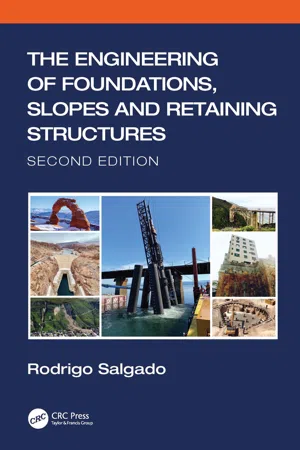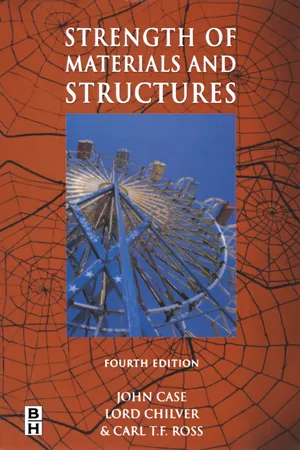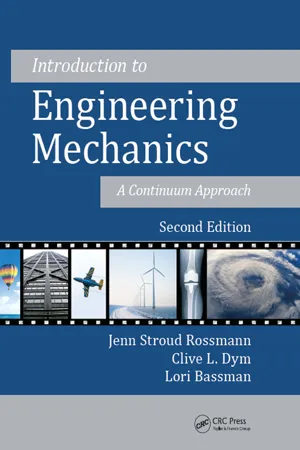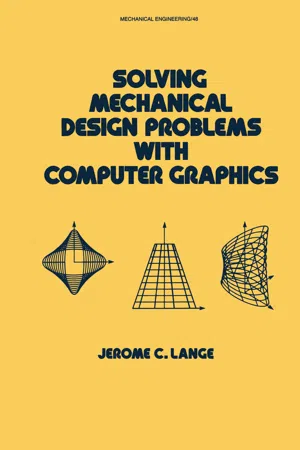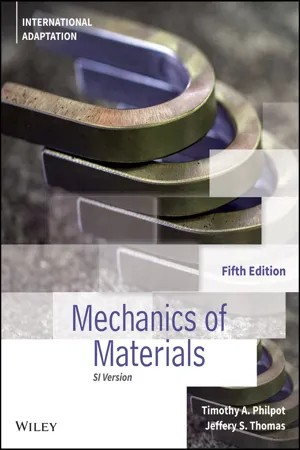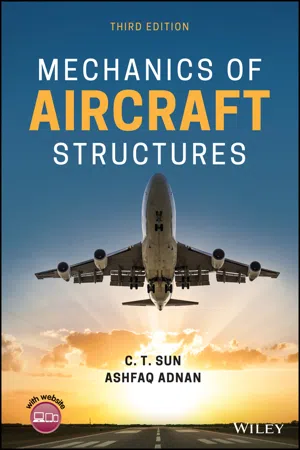Technology & Engineering
Shear Strain
Shear strain refers to the deformation that occurs when parallel surfaces within a material slide past each other in response to applied shear stress. It is a measure of the change in shape or distortion of the material due to shear forces. Shear strain is typically expressed as the ratio of the displacement between the parallel surfaces to the original distance between them.
Written by Perlego with AI-assistance
Related key terms
Related key terms
1 of 4
Related key terms
1 of 3
8 Key excerpts on "Shear Strain"
- Rodrigo Salgado(Author)
- 2022(Publication Date)
- CRC Press(Publisher)
8 of a square element with sides aligned with respect to two reference axes.Just as is true for stress, the state of strain at a point is described by a tensor: the strain tensor. There are three independent Shear Strain tensor components, one for each pair of reference axes. The component ε13 = ½γ13 expresses half the increase in the initial 90° angle formed by two perpendicular infinitesimal linear elements aligned with reference axes x1 and x3 . The engineering Shear Strain is twice the corresponding strain tensor component:(4.27)γ= 2i jεi jBoth normal and Shear Strains εij can be expressed through(4.28)ε= −i j1 2()+∂u i∂x j∂u j∂x iwhere i, j = 1, 2, 3 = reference directions, xi = coordinate in the i direction, and ui = displacement in the xi direction. The subscripts indicate the directions of linear differential elements and the directions in which displacements of the end points of the differential elements are considered. When i = j, the strain is a normal strain; it is a Shear Strain otherwise. There are theoretically nine numbers resulting from Equation (4.28), which together constitute the strain tensor. Of these nine, only six are independent. In this and in any mathematical aspect, the strain tensor is like the stress tensor discussed earlier.Example 4.5Derive, in a simple way, the expression for the normal strain at a point in the direction of reference axis x1 .Solution:Let’s consider the case of E-Figure 4.4 . For an undeformed soil mass, we have a differential element dx1 aligned with the x1 direction (E-Figure 4.4 ). We have labeled the initial point of the segment A and the end point B. In drafting this figure, we have corrected for rigid body translation in the x1 direction. In other words, we are plotting the deformed element as if the displacement of A were zero for easier comparison with the original, undeformed element. This way, every displacement in the figure is relative to the displacement of A. If, after the soil mass is deformed, point B moves more in the positive x1 direction than point A (that is, if the displacement u1 of B is greater than that of A), as shown in E-Figure 4.4 , then the element has clearly elongated (this elongation is seen in the figure as B* – B- eBook - ePub
- Carl T. F. Ross, The late John Case, A. Chilver(Authors)
- 1999(Publication Date)
- Butterworth-Heinemann(Publisher)
5Analysis of stress and strain
5.1 Introduction
Up to the present we have confined our attention to considerations of simple direct and shearing stresses. But in most practical problems we have to deal with combinations of these stresses.The strengths and elastic properties of materials are determined usually by simple tensile and compressive tests. How are we to make use of the results of such tests when we know that stress in a given practical problem is compounded from a tensile stress in one direction, a compressive stress in some other direction, and a shearing stress in a third direction? Clearly we cannot make tests of a material under all possible combinations of stress to determine its strength. It is essential, in fact, to study stresses and strains in more general terms; the analysis which follows should be regarded as having a direct and important bearing on practical strength problems, and is not merely a display of mathematical ingenuity.5.2 Shearing stresses in a tensile test specimen
A long uniform bar, Figure 5.1 , has a rectangular cross-section of area A. The edges of the bar are parallel to perpendicular axes Ox, Oy, Oz. The bar is uniformly stressed in tension in the x-direction, the tensile stress on a cross-section of the bar parallel to Ox being σx . Consider the stresses acting on an inclined cross-section of the bar; an inclined plane is taken at an angle θ to the yz-plane. The resultant force at the end cross-section of the bar is acting parallel to Ox .Figure 5.1 Stresses on an inclined plane through a tensile test piece.For equilibrium the resulrant force parallel to Ox on an inclined cross-section is alsoP = A σx. At the inclined cross-section in Figure 5.1 , resolve the forceA σx - eBook - ePub
Introduction to Engineering Mechanics
A Continuum Approach, Second Edition
- Jenn Stroud Rossmann, Clive L. Dym, Lori Bassman(Authors)
- 2015(Publication Date)
- CRC Press(Publisher)
Shear Strain.To visualize the effect of Shear Strain, consider a motor mount as shown in Figure 2.5a . The motor mount is composed of a block of elastic material (our “body”) with attachments to allow for connection to the base of the motor and the support structure. A force P is applied at the top of the block, and the support structure resists with an equal and opposite force P. This subjects the block/body (of initial height L) to a pair of shear forces, as shown in Figure 2.5b . If we imagine that the block is composed of many thin layers and that each layer will slide slightly with respect to its neighbor, we may visualize how the angular distortion of the block will develop, resulting in maximum displacement Δsat the top of the block.As for normal strain, several definitions of Shear Strain exist. The engineering shear deformation incurred is ϕ, the change in an initially right angle, as shown in Figure 2.5b . This is the formal definition of Shear Strain: the change in the angle between two initially perpendicular planes. It is measured in radians and hence, like normal strain, is dimensionless. However, it is often difficult to take precise measurements of these angular changes, especially for very small deformations. For small deformations, the tangent of the angle ϕ will closely approximate ϕ itself, so that we can approximate the Shear Strain gamma by:FIGURE 2.5Shear Strain. (a) Motor mount. (b) Motor mount distorted in shear.γ = ϕ ≈ tan ϕ =.Δ sL(2.5) With normal and Shear Strain defined, we are equipped to address the kinematics of deformation of continuous materials due to loading. In Section 2.2 - eBook - ePub
Woven Textile Structure
Theory and Applications
- B K Behera, P K Hari(Authors)
- 2010(Publication Date)
- Woodhead Publishing(Publisher)
φ in radian is also a number. There are different types of strain as described below.Normal strain is a ratio of change in dimension to the original dimension. It is denoted by ε :Normal strain is also called linear strain; the tensile strain is considered positive and compressive strain is considered negative.Shear Strain is the angular deformation due to shear stress. Consider a rectangular block held at the bottom subjected to tangential force P as shown in Fig. 7.2 . If the face ABCD is distorted to A′B′CD through an angle φ , the angular deformation produced is called Shear Strain:7.2 Shear Strain.Volumetric strain is the ratio of change in volume to original volume. Thus volumetric strain can be shown as:where δV = change in volume and V = original volume.Volumetric strain is the sum of strains in the three mutually perpendicular directions:whereεx,εyandεzare strains in three mutually perpendicular directions x , y , z respectively.7.2.4 Hooke’s law and modulus
For deformation within elastic limit, normal stress is directly proportional to normal strain. Mathematically:where E is constant of proportionality known as modulus of elasticity or Young’s modulus. Similarly, shear stress (τ ) within elastic limit is directly proportional to Shear Strain. Mathematically.where G is the constant of proportionality known as shear modulus.The SI unit of modulus of elasticity (E ) is the pascal, N/m2 . Modulus can be calculated from the slope of the straight-line portion of the stress–strain curve.7.2.5 Poisson ratio
Tensile or compressive axial strain is accompanied by lateral strain. The lateral strain is a fraction of the linear strain and within the elastic limit bears a constant ratio to the linear strain and is called the Poisson ratio. σ n represents the Poisson ratio for the lateral direction as it gives the contraction due to longitudinal extension. The suffixn - Jerome Lange(Author)
- 2021(Publication Date)
- CRC Press(Publisher)
Figure 4.3 shows a shear stress acting on the end of a bar. Shear stress is represented here by t (tau).FIGURE 4.3Shear stress.4.2 STRAINStrain is deformation divided by the length in which the deformation occurs. Since strain is a length divided by a length, it is dimensionless. Strain is a vector.Normal strain is deformation divided by a length which is parallel to the deformation. Normal strain is represented here by e (epsilon).Figure 4.4a shows a body that is subjected to the forces F1 , F2 , F3 , and F4 , and a small element with dimensions dx and dy. Figure 4.4b shows the element subjected to normal strain; the rectangle ABCD is the element before straining; the rectangle AB1 C1 D1 is the element after straining.The deformation in the x direction is a dx, and the normal strain in the x direction isFIGURE 4.4(a) Body; (b) element subjected to normal strain; (c) element subjected to Shear Strain; (d) element subjected to general condition of strain.which is also called the x component of the strain. The deformation in the y direction is b dy; therefore, the normal strain in the y direction isε X== aadxdxwhich is also called the y component of the strain.ε y== bbdydyShear Strain is deformation divided by a length which is perpendicular to the deformation. Shear Strain is represented here by σ(gamma).Figure 4.4c shows the element subjected to Shear Strain. The rectangle ABCD is the element before straining; the rhombus AB2 C2 D2 is the element after straining.The Shear Strain is defined as the change in the right angle at A; but with the condition that the deformation is very small; it is satisfactory to take the change in the right angle at A as the sum of the tangents of the angles α1 and α2 . Thus the Shear Strain isγ = tanα 1+ tanα 2=+mdxdx= m + nndydyFigure 4.4d shows the element in a general condition of strain, the result of superposing Fig. 4.4b and c. Here the rectangle ABCD is the element before straining, and the rhombus AB3 C3 D3- eBook - ePub
- Timothy A. Philpot, Jeffery S. Thomas(Authors)
- 2022(Publication Date)
- Wiley(Publisher)
γ ≈ 1, then Shear Strain can be defined as(2.3 )(2.4)Shear Strain.FIGURE 2.4aFront view of Shear Strain.FIGURE 2.4bFor those cases in which the deformation is nonuniform, the Shear Strain at a point, γxy (O), associated with two orthogonal reference lines x and y, is obtained by measuring the shear deformation as the size of the element is made smaller and smaller. In the limit,Since Shear Strain is defined as the tangent of the angle of distortion, and since the tangent of that angle is equal to the angle in radians for small angles, an equivalent expression for Shear Strain that is sometimes useful for calculations is(2.5 )In this expression, θ′ is the angle in the deformed state between two initially orthogonal reference lines.Units of Strain
Equations (2.3) through (2.5 ) indicate that Shear Strains are dimensionless angular quantities, expressed in radians (rad) or microradians (μrad). The conversion from radians, a dimensionless quantity, to microradians is 1 μrad = 1 × 10−6 rad.Measuring Shear Strains Experimentally
Shear Strain is an angular measure, and it is not possible to directly measure the extremely small angular changes typical of engineered structures. However, Shear Strain can be determined experimentally by using an array of three strain gages called a strain rosette . Strain rosettes will be discussed in more detail in Chapter 13 .Sign Conventions for Shear Strains
Equation (2.5) shows that Shear Strains will be positive if the angle θ′ between the x and y axes decreases. If the angle θ′ increases, the Shear Strain is negative. To state this relationship another way, Equation (2.5) can be rearranged to give the angle θ - eBook - ePub
- C. T. Sun, Ashfaq Adnan(Authors)
- 2021(Publication Date)
- Wiley(Publisher)
5 Bending and Flexural Shear5.1 INTRODUCTION
Bending is the most frequently occurring form of load in aircraft structures. As the name implies, a bending load “bends” a structure and, depending on the direction of the lateral forces or bending moments, results in the development of nonuniform tensile and compressive stresses normal to the cross‐section and transverse shear stress parallel to the cross‐section. A shear force–bending moment diagram can be constructed to analyze and visualize the nature of the internal shear forces and bending moments at any location on the structure.The intuitive approach for solving a problem would be using a direct method where the applied bending forces would have been first linked with the internal resultants and stress components. Then, using the stress–strain law, strain components would be obtained. Finally, the associated displacements would be obtained via strain–displacement relations. However, there is no direct method to analytically solve a bending problem. As such, inverse or semi‐inverse methods such as theory of elasticity are often used. The theory of elasticity approach is useful for solids with narrow section or axisymmetric circular sections. An analysis becomes very cumbersome and often intractable when the loading becomes complicated. For thin‐walled sections such as boxed‐beam section or multichannel section, analytical solutions are not possible even for simpler loadings. When loadings are only lateral and deformation is not large, a simpler inverse approach, called Bernoulli–Euler beam theory is used. The main disadvantage of the Bernoulli–Euler beam theory is that this theory is not applicable when transverse shear deformation is important. In such a situation, the Timoshenko beam theory is appropriate. For excessive bending deformation, other methods such as inelastic bending or plastic bending approaches are often used. However, when both the section geometries and loadings get complicated, none of the analytical methods will work. In such situations, numerical methods such as finite element and finite difference methods need to be used. - eBook - ePub
Art Conservation
Mechanical Properties and Testing of Materials
- W. (Bill) Wei(Author)
- 2021(Publication Date)
- Jenny Stanford Publishing(Publisher)
In conservation, we are generally dealing with stresses and eventually things breaking when the stress reaches the material’s strength. However, in many engineering/industrial applications, and in some exceptional cases in conservation, especially of industrial heritage objects, one failure criterion is that something deforms too much. The next time the reader flies in a passenger airplane, take a look at the front of the jet engine. There, one will see the so-called fan turning. In operation, each fan blade will be loaded by a centrifugal force, which translates into a stress, which further translates into strain of the blade during flight. It is not particularly pleasant if the strain is so great that the fan blade comes in contact with the turbine engine housing. Thus, analogous to the force/stress situation, engineers who design these parts cannot go to suppliers and expect them to tell them how much a material will lengthen under a given force. They must translate that into strain under a given stress. The supplier can then provide information on the strain behavior of materials, information which is useful for every client.2.3 The Relationship between Stress and StrainStress and strain are related as one might expect. As the force is increased for the tensile test discussed in Fig. 2.1 or 2.6 , a graph will be obtained showing the relationship between the applied force on the specimen and the change in length for a typical metal (see Fig. 2.8a ). These results can be calculated into stress and strain based on the original load-carrying area of the specimen, A0 , and the original length of the specimen l0 , as defined in Fig. 2.6 . This results in a so-called engineering stress-strain (σ-ε) diagram as shown schematically in Fig. 2.8b .Figure 2.8 Schematic (a) load elongation and (b) stress-strain diagrams for a typical metal.For most metals, the increase in strain with an increase in stress begins as a straight line. This is called “linear” behavior. This part of the graph also describes something known as elastic behavior. If you stressed the material to, say point 2 in Fig. 2.8b and then unstressed it, the specimen would go back to its original length. A material is thus called elastic in technical terms when it returns back to its original form after being deformed. If the stress-strain curve is a straight line as in the lower part of Fig. 2.8b , we say that the material shows linear-elastic behavior.At a certain point for metals, the stress level, σy , the curve starts to bend and eventually reaches a maximum at the stress level, σUTS in the tensile case, or more generally, σf . The curve then bends down to the X which marks the point at which the specimen breaks or technically, fractures
Index pages curate the most relevant extracts from our library of academic textbooks. They’ve been created using an in-house natural language model (NLM), each adding context and meaning to key research topics.
Explore more topic indexes
Explore more topic indexes
1 of 6
Explore more topic indexes
1 of 4
